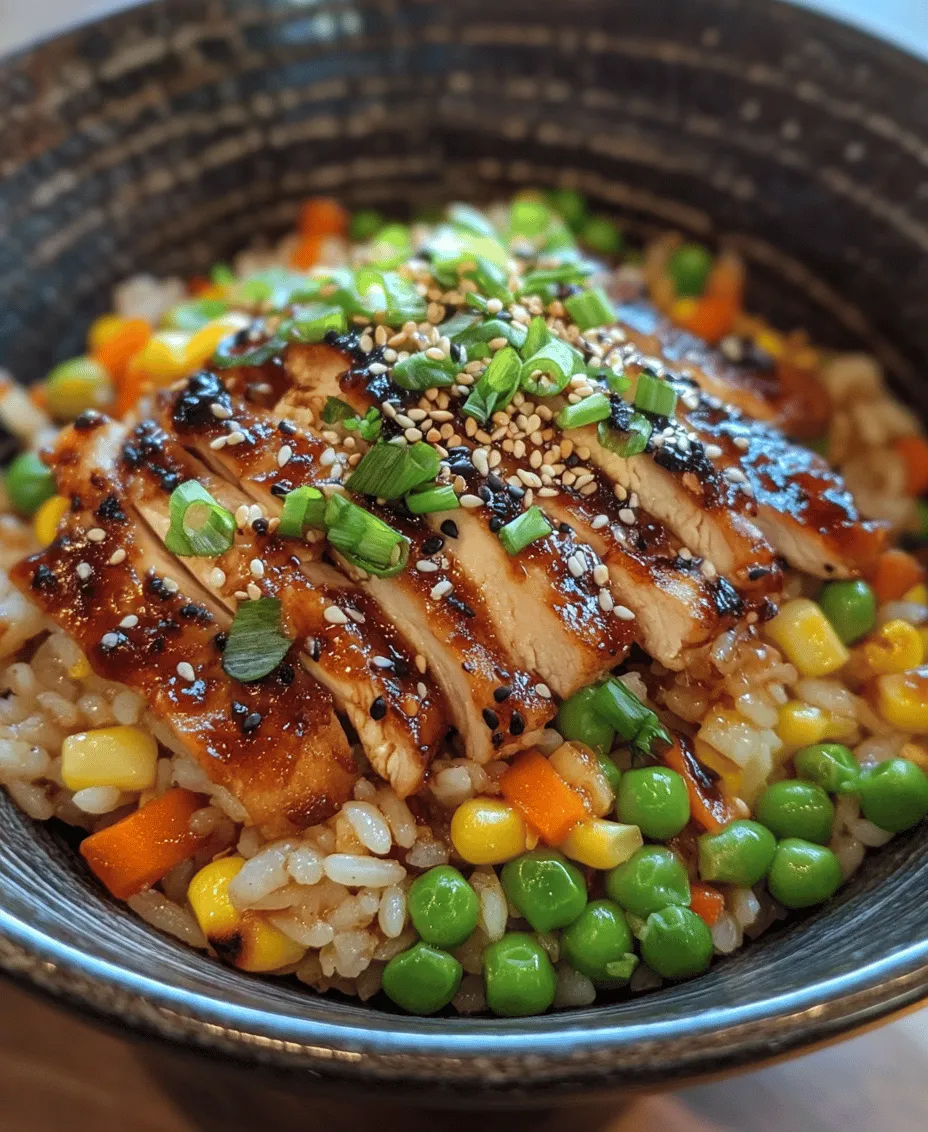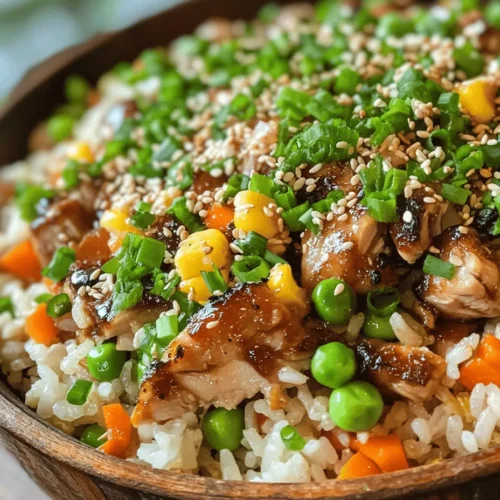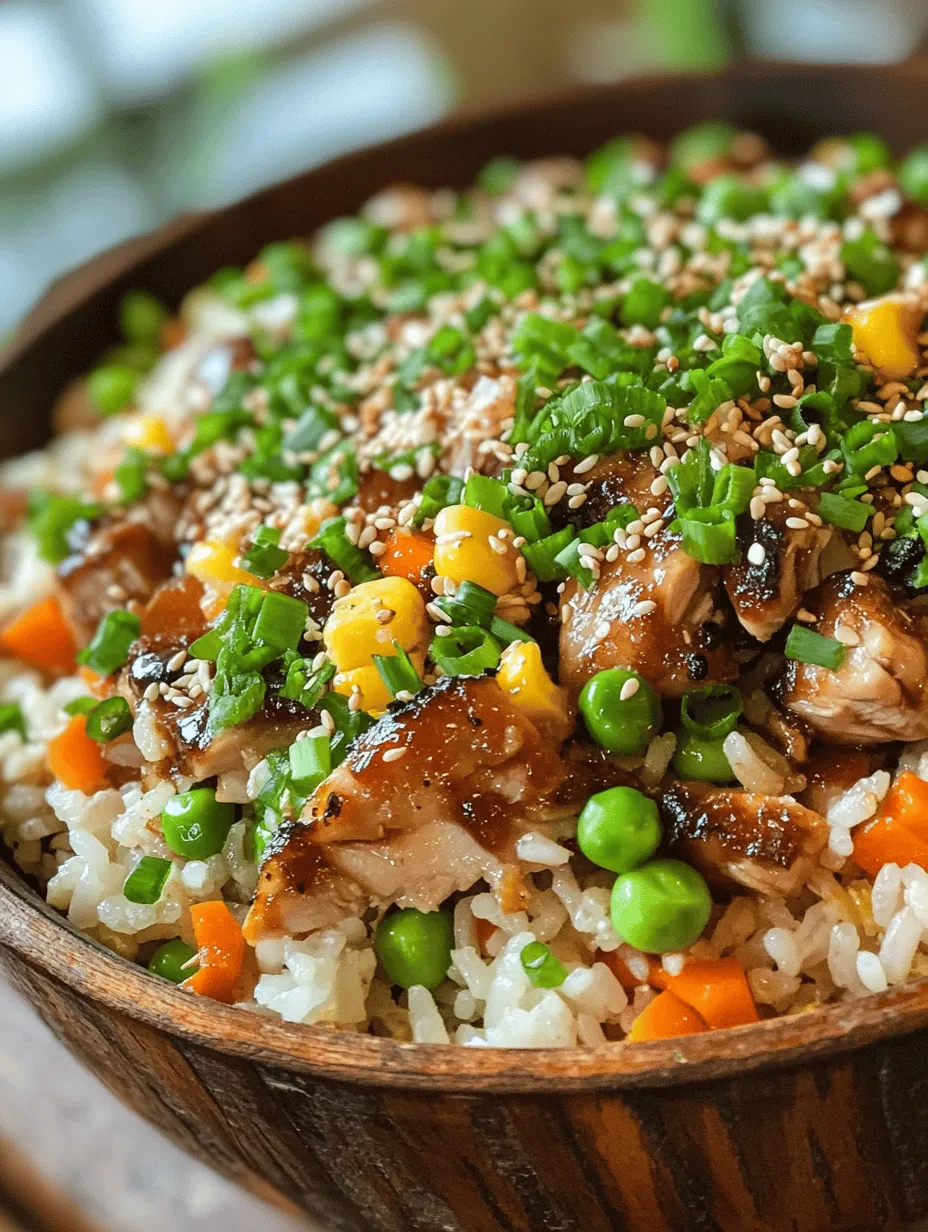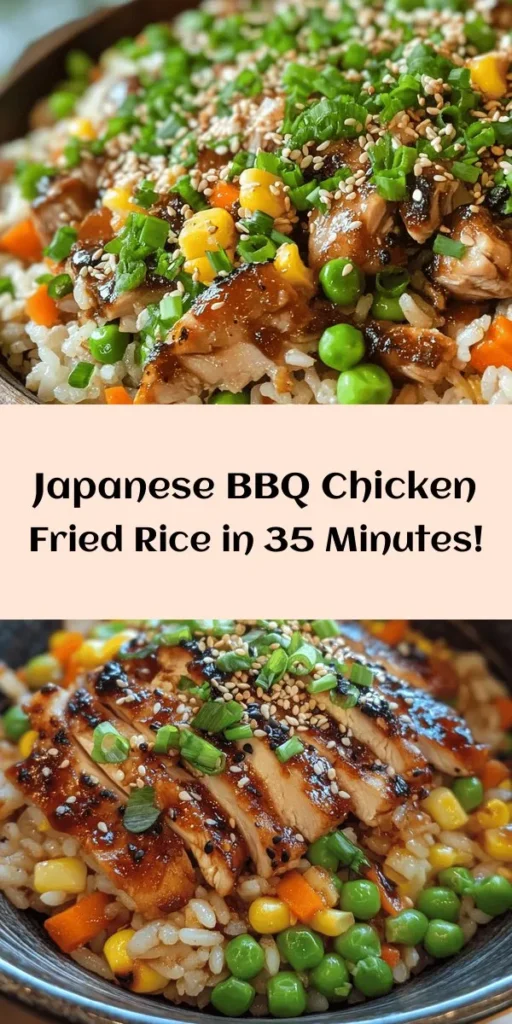Introduction
Fried rice is a staple in many cuisines around the world, but in Japan, it takes on a unique character that celebrates the country’s rich culinary traditions. The Savory Japanese BBQ Chicken Fried Rice Extravaganza is not just a meal; it’s a vibrant dish that encapsulates the essence of Japanese home cooking. This dish is a perfect illustration of how simple ingredients can be transformed into a flavor-packed delight, making it a beloved choice in Japanese households.
Fried rice holds a special place in Japanese cuisine, often prepared as a quick and satisfying meal that utilizes leftover rice and whatever vegetables or proteins are on hand. Its versatility allows for endless variations, each reflecting personal tastes and regional ingredients. The Savory Japanese BBQ Chicken Fried Rice stands out with its perfect balance of savory and slightly sweet flavors, achieved through the use of traditional Japanese seasonings like soy sauce and mirin. The rich umami notes combined with the smoky essence of BBQ chicken create a symphony of flavors that resonate with anyone fortunate enough to enjoy it.
As we delve into this recipe, prepare to be enveloped in the warm aromas of garlic and ginger, paired with the sweetness of mirin and the savory depth of soy sauce. It’s a dish that not only nourishes but also evokes the comfort of family meals, making it an ideal choice for weeknight dinners or gatherings with friends.
Understanding the Key Ingredients
Jasmine Rice
The foundation of any great fried rice dish is the rice itself, and in this recipe, we use jasmine rice. This long-grain variety is known for its delicate floral aroma and slightly sticky texture, making it the perfect choice for fried rice. When cooked correctly, jasmine rice provides a light and fluffy base that allows the other ingredients to shine without becoming overly mushy. To achieve the perfect texture, it’s recommended to rinse the rice before cooking to remove excess starch, which can lead to clumping. Day-old rice is ideal for this dish because it dries out slightly in the refrigerator, preventing the grains from sticking together during frying.
Marinating Chicken Thighs
In this recipe, we will be using chicken thighs, which are favored for their rich flavor and moist texture. Marinating the chicken is a crucial step that enhances its taste and tenderness. A simple marinade of soy sauce, mirin, and sesame oil allows the chicken to absorb all the savory goodness, infusing each bite with delicious flavor. The marinating process not only enhances the taste but also helps to tenderize the meat, ensuring that it remains juicy and flavorful after cooking. Ideally, the chicken should marinate for at least 30 minutes, but for maximum flavor absorption, longer marination (up to several hours) is recommended.
Soy Sauce and Mirin
Soy sauce and mirin are cornerstones of Japanese cooking, each bringing its own unique flavor profile to the table. Soy sauce, with its deep umami flavor, adds a savory depth to dishes, while mirin contributes a subtle sweetness that balances the saltiness of the soy sauce. Together, they create a harmonious blend that enhances the overall taste of the fried rice. Mirin, a sweet rice wine, also helps to caramelize the chicken during cooking, creating a beautiful glaze that adds both flavor and visual appeal to the dish.
Sesame Oil and Vegetable Oil
In this recipe, we utilize both sesame oil and vegetable oil, each bringing distinct benefits. Sesame oil, with its nutty aroma and flavor, adds a fragrant finish to the dish. It’s best used in moderation due to its strong flavor. On the other hand, vegetable oil is perfect for high-heat cooking, ensuring that the chicken and vegetables fry evenly without burning. Combining these oils allows for a well-rounded flavor profile and enhances the overall cooking experience.
Mixed Vegetables
The addition of mixed vegetables not only boosts the nutritional value of the dish but also contributes to its vibrant color and texture. Colorful vegetables such as bell peppers, peas, and carrots provide essential vitamins and minerals while adding a satisfying crunch. When selecting vegetables, feel free to choose your favorites or whatever is in season. The key is to ensure that they are cut into uniform sizes to promote even cooking.
Aromatics: Garlic, Ginger, and Green Onions
Finally, we cannot overlook the importance of aromatics in this dish. Fresh garlic and ginger are essential for building flavor, providing a warm, aromatic base that elevates the dish to new heights. They should be sautéed just until fragrant, as this releases their essential oils and flavors into the oil. Green onions, with their mild onion flavor, add a fresh finish and a pop of color when sprinkled on top just before serving. These ingredients are what truly bring the Savory Japanese BBQ Chicken Fried Rice to life.
Step-by-Step Cooking Process
Marinating the Chicken
To begin, we’ll marinate the chicken thighs to infuse them with flavor. In a medium bowl, combine soy sauce, mirin, sesame oil, and a pinch of black pepper. Add the chicken thighs, ensuring they are fully submerged in the marinade. Cover the bowl with plastic wrap and refrigerate for at least 30 minutes. For the best results, aim for a marination time of 2 to 4 hours; this allows the chicken to absorb more flavors and become incredibly tender.
Preparing Day-Old Rice
While the chicken is marinating, it’s time to prepare the rice. If you don’t have leftover rice on hand, you can cook jasmine rice according to package instructions, then spread it out on a baking sheet to cool. Once cooled, refrigerate the rice for at least an hour. The goal is to have rice that is dry and slightly firm, as this prevents it from becoming mushy during the frying process. Day-old rice is ideal because it has had time to dry out in the fridge, making it easier to achieve that perfect fried rice texture.
Cooking Techniques: Skillet vs. Wok
When it comes to frying the rice, you have two primary options: a skillet or a wok. A wok is traditionally used in Asian cooking due to its shape, which allows for high heat and quick cooking. The sloped sides make it easy to toss and stir ingredients without spilling. However, if you don’t have a wok, a large skillet can work just as well. The key is to ensure the pan is large enough to accommodate all your ingredients without overcrowding, which can lead to steaming rather than frying.
Sautéing Aromatics
With your chicken marinated and rice ready, it’s time to start cooking. Heat a tablespoon of vegetable oil in your skillet or wok over medium-high heat. Once the oil is shimmering, add minced garlic and ginger. Sauté these aromatics for about 30 seconds until they are fragrant, being careful not to let them burn. The goal is to release their essential oils, which will infuse the oil and flavor the entire dish.
Incorporating Vegetables
Next, add your mixed vegetables to the pan. Depending on the types of vegetables you’ve chosen, you may want to add them in stages, starting with those that take longer to cook, such as carrots and bell peppers. Stir-fry the vegetables for 2-3 minutes, just until they are tender yet still crisp. This will ensure they maintain their vibrant color and crunch in the final dish.
Egg Scrambling Technique
In a separate bowl, crack a couple of eggs and whisk them until the yolks and whites are well combined. Push the sautéed vegetables to one side of the pan and add a little more oil if needed. Pour the eggs into the empty space and let them sit for a moment before gently scrambling them. The key to fluffy scrambled eggs is to cook them on medium heat and to avoid over-stirring. Once they are just set, mix them with the vegetables.
Combining Ingredients
Finally, it’s time to bring everything together. Add your marinated chicken to the pan, cooking until it is no longer pink and has reached a safe internal temperature. Once the chicken is cooked, add the day-old rice, breaking up any clumps with your spatula. Pour in additional soy sauce and mirin to taste, ensuring that the rice is evenly coated. Stir-fry everything together for a few minutes, allowing the flavors to meld and the rice to heat through completely.
The Savory Japanese BBQ Chicken Fried Rice Extravaganza is nearly complete. With its rich flavors and delightful textures, this dish promises to be a crowd-pleaser for any occasion. As we continue to explore this recipe, we will delve into final touches and serving suggestions that will elevate your culinary creation to new heights.

Flavor Enhancements and Variations
To take your Savory Japanese BBQ Chicken Fried Rice to the next level, consider incorporating some optional ingredients that enhance flavor and add a unique twist. One popular addition is gochujang, a Korean chili paste that brings a spicy kick to your dish. Mixing in a tablespoon or two of gochujang while sautéing your vegetables can elevate the flavor profile by introducing a delightful heat and a hint of sweetness. If you prefer a milder dish, you can adjust the amount to suit your taste.
Additionally, don’t hesitate to get creative with the vegetables you include in your fried rice. Seasonal variations can keep the dish exciting and highlight fresh produce. For spring, consider adding asparagus or peas; in summer, zucchini and bell peppers shine. Fall can bring in roasted pumpkin or sweet potatoes, while winter might inspire you to use hearty greens like kale or bok choy. The beauty of fried rice lies in its versatility, allowing you to customize it based on your preferences and what you have on hand.
Protein alternatives also offer exciting opportunities for variation. If you want to make this dish vegetarian, consider swapping out the chicken for tofu, which can absorb flavors beautifully when marinated and sautéed. For seafood lovers, shrimp can be a fantastic substitute; just be sure to cook them until they are pink and opaque. Additionally, beef, whether ground or thinly sliced, can add a different depth of flavor, making this dish adaptable for various dietary preferences.
For those with specific dietary needs, adapting the recipe is simple. To make it gluten-free, use tamari instead of soy sauce and ensure that all other ingredients are certified gluten-free. Vegetarians can easily enjoy this recipe by following the tofu suggestion mentioned earlier, ensuring a delicious, meat-free alternative.
Presentation and Serving Suggestions
Presentation is key in Japanese cuisine, as visual appeal enhances the dining experience. Serve your Savory Japanese BBQ Chicken Fried Rice hot, as this is when the flavors are most vibrant. Consider garnishing with finely chopped green onions, sesame seeds, or a drizzle of sesame oil for added flavor and visual appeal. A dash of furikake, a Japanese rice seasoning, can also provide a beautiful finish and an extra layer of umami.
When it comes to pairing suggestions, think about complementary side dishes or beverages that can enhance your meal. A light, crisp cucumber salad dressed in rice vinegar and sesame oil can provide a refreshing contrast to the savory fried rice. For those who enjoy beverages, a chilled Japanese lager or a cup of green tea can beautifully complement the dish’s flavors.
Storing and reheating your fried rice properly is essential to maintain its integrity. Allow the fried rice to cool before transferring it to an airtight container, where it can be stored in the refrigerator for up to three days. When reheating, use a skillet on medium heat with a splash of water or broth to prevent the rice from drying out. This method helps retain moisture without making the rice soggy, ensuring every bite is as delightful as the first.
Culinary Tips for Perfect Fried Rice
While fried rice is a straightforward dish, there are common pitfalls that can hinder your results. One of the most frequent mistakes is using freshly cooked rice. Instead, always use day-old rice if possible, as the grains dry out slightly, reducing stickiness and allowing for better frying. If you must use fresh rice, spread it out on a baking sheet and allow it to cool for at least 30 minutes before cooking.
Another critical factor is the heat level during cooking. High heat is essential for achieving that perfect texture and flavor. Use a wok or a large skillet to ensure even cooking, and allow the pan to preheat before adding any ingredients. This technique helps to sear the ingredients quickly, locking in flavors and creating a delightful char that adds depth to your fried rice.
When it comes to balancing flavors, aim for a combination of salty, sweet, and umami notes. The soy sauce will provide the salty component, while the addition of mirin or a touch of sugar can introduce sweetness. Don’t forget to taste as you go; this process allows you to adjust seasonings based on your preferences and ensures a harmonious blend of flavors.
Cultural Significance of Fried Rice in Japan
Fried rice, or “chahan” in Japanese, has a rich history that reflects the evolution of Japanese cuisine. While it is believed to have been influenced by Chinese cooking, fried rice has become a staple in Japanese households, often regarded as a comfort food. Traditionally, it was made from leftover rice, showcasing the Japanese value of minimizing waste and maximizing flavor.
The dish represents the essence of home-cooked meals and family gatherings in Japan. It is often prepared with love and care, bringing families together around the table. In restaurants, fried rice is frequently customized with various ingredients to cater to individual tastes, making each serving a unique expression of culinary creativity.
Globally, fried rice has adapted to various cultural influences while retaining its Japanese roots. Different regions may infuse local ingredients and flavors, creating a diverse array of fried rice dishes that reflect the community’s culinary identity. This adaptability highlights the universal appeal of fried rice, making it a beloved dish worldwide.
Conclusion
In summary, the Savory Japanese BBQ Chicken Fried Rice is more than just a meal; it is a celebration of flavor, simplicity, and cultural significance. With its adaptable nature, you can experiment with ingredients to make it a personal favorite, whether by adding a spicy kick, incorporating seasonal vegetables, or choosing a protein that suits your dietary needs.
As you embark on this culinary journey, remember to enjoy the process of cooking and sharing this dish with loved ones. The joy of preparing a meal that brings people together is what makes cooking truly special. So gather your ingredients, embrace your creativity, and savor the delightful experience of crafting your own version of this Japanese classic.



